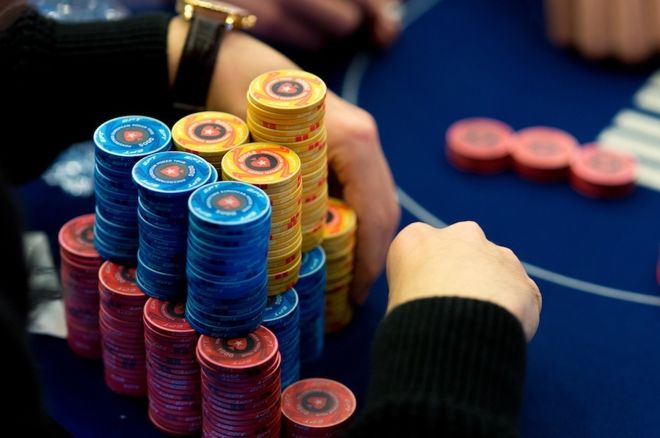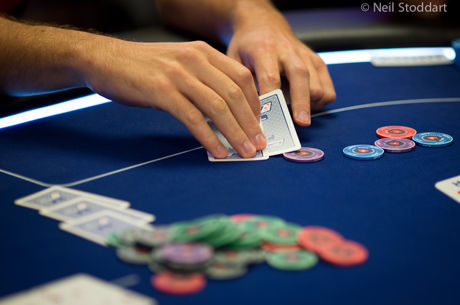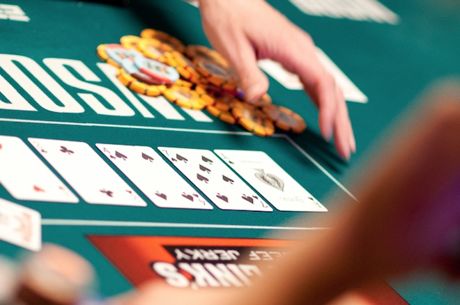10 More Hold'em Tips: Should You Ever Limp-Reraise?

Even new no-limit hold'em players tend to learn early on that most of the time — and for a variety of reasons — it is better to open with a raise than to limp before the flop.
Like everything in poker, this isn't a hard-and-fast rule with no exceptions. Sometimes circumstances make limping a viable option, including in multi-way pots where it appears you can limp in after others and see a flop cheaply with great pot odds.
But if it folds to you and you are opening the action, limping generally works as an invitation to others to raise after you. If you're limping with a speculative hand — like a small pocket pair, two random suited cards, unsuited connectors, and so on — you're likely not going to want to limp and then call a raise, especially if you'll be out of position after the flop.
You see weak players do that a lot, actually — limping, then calling. The limp was a passive play (calling the big blind, not raising), and so was the call that came afterwards. A lot of inexperienced and/or lesser-skilled hold'em players tend toward passivity, which is why you'll see them limp-calling before the flop.
Every once in a while, though, you might see a player make what is in most cases an unusual play before the flop — limping in, then reraising. In other words, the player unexpectedly goes from being passive to being aggressive, all on the same betting round!
Why would a player do this, though? Under what circumstances is the limp-reraise ever a good play to make before the flop?
Limp-Reraising With Premium Hands from Early Position
The limp-reraise is essentially a kind of trap or slow play — a show of weakness that encourages others' aggression, followed by the surprise reraise that builds a bigger pot if called or at least wins more than just the blinds and antes if others fold.
There was a time in the not-too-distant past that a player trying the limp-reraise almost always had exactly one hand — pocket aces. Some will also try the limp-reraise with pocket kings or pocket queens, or even ace-king. One problem, of course, is that if the only time you ever limp-reraise you do it with premium hands, you have signaled loudly the strength of your hand to a table full of attentive players.
That said, there are situations when you don't mind so much revealing that you have a strong hand preflop.
One frequent and often successful use of the limp-reraise comes when there have been several preflop limpers, then a player in late position or the blinds decides to make a big raise or all-in shove to claim all of the "dead money" in the middle. Some players will even do this with a weak hand — kind of a variation on the "squeeze play" — since it can be very hard to call a big raise with so many other players involved. Or in a tournament situation, a relative short stack might see all the limpers as an opportunity to earn a big boost in chips without having to show a hand, and so push all in.
In these situations, the player who limped in along with others holding aces or kings is quite inconspicuous, hiding among a crowd of other seemingly-passive players. Reraising can earn a nice-sized pot if everyone folds. Or if the raiser is all in, limp-reraising puts the player in great shape to play a hand heads-up against an inferior hand and win a big pot.
Note, however, that as in this scenario, limp-reraising is typically a play made...
- from early position (often under the gun), and
- with a premium hand (like aces, kings, or perhaps queens and ace-king).
It also helps if you have somewhat aggressive players behind you, at least one of whom you expect will likely be raising. There's a certain category of players who don't like letting players see flops inexpensively, and make it a habit of raising versus limpers. Having such players at your table makes the limp-reraise a more attractive play to try.
Limp-Reraising as a Bluff
It's possible to limp-reraise as a bluff — that is, without a premium hand — although there need to be a number of specific criteria in place in order for the play to be entertained.
First off, whenever you limp from early position, you aren't going to know how the rest of the table will respond. You may be facing a single opponent or many. If you're at a tight table, you can sometimes limp from early position with a reasonable assurance only one player will be raising — say, an aggressive opponent the late position or in the blinds who has been terrorizing the table with bets and raises.
In such a spot, you might limp with some knowledge this particular player will raise after you, likely with a very wide range of hands including many weak hands. You then limp-reraise — what should be an unexpected (and aggressive-seeming) move — and get a fold. You might try this with medium-strength hands or hands like J♣10♣ with which it wouldn't be terrible to get called and see a flop, as your hand will be very well disguised if you happen to flop well. If reraised back, though, you're tossing your attempted bluff away.
Don't Try Limp-Reraising from Late Position
Meanwhile trying to limp-reraise from late position is generally less recommended. The problem here should be obvious — there are fewer players left to act behind you, and therefore less of a chance someone will raise and give you the opportunity to reraise.
Say you limp in from the cutoff with pocket aces. You're hoping the button, small blind, or big blind will raise behind you so you can try the limp-reraise, but if none of them has a raising hand (not unlikely), you're probably stuck playing your aces against two or three opponents.
You're still going to be ahead going to the flop, but pocket aces can become troublesome very fast in a multi-way situation if the flop comes coordinated and other players begin showing interest with bets and raises. Don't stumble into this circumstance by trying to get fancy limping your aces from late position.
Limp-Reraising in Blind-vs.-Blind Situations
The one spot where limp-reraising with something less than a premium hand can be warranted is when the table folds around to you in the small blind, meaning you're heads-up with the big blind. This is a fairly common spot for players to limp-reraise, and with a wider range of hands.
Not unlike the category of "no-limping-allowed-at-my-table" players mentioned above, a lot of players will raise from the big blind if the small blind tries merely to call and see a flop. It's a profitable play for the big blind to make. The SB has shown weakness by limping, increasing the chance of a fold to a raise. Also, if the SB does call the raise, the BB will have the positional edge after the flop, affording more chances to take the pot away.
This tendency makes the limp-reraise an option for the small blind. Generally you'll want an above-average hand or good speculative hand (e.g., suited connectors) that can potentially flop well, in case your limp-reraise is called.
Final Thoughts
The limp-reraise is not a play you want to try all that frequently, nor should it be done merely for the sake of novelty. Sometimes when playing poker online you'll see players limp-reraising in all sorts of strange spots and with odd holdings, but more often than not they're not making the play with a lot of foresight or calculation (especially when playing at the "micros" or lower limits).
As noted, in most cases the limp-reraise is going to be a play made with a strong hand, except for those very rare spots when bluffing or in blind-vs.-blind situations. Occasionally it can be a decent method to get action with your big hands when simply open-raising seems likely to do so. But more often than not, limping with premium hands like aces is not recommended, and often becomes the first detail in the story of aces getting cracked.
Also in this series...
- Game Selection
- Playing Weak Aces
- Making the Squeeze Play
- The Stop-and-Go
- The Float Play
- Stealing and Restealing
- Overbetting
- Light Three-Betting and Four-Betting
- Understanding Expected Value
Ready to take a seat at the table? Put these hold'em tips into practice at PokerStars.
Be sure to complete your PokerNews experience by checking out an overview of our mobile and tablet apps here. Stay on top of the poker world from your phone with our mobile iOS and Android app, or fire up our iPad app on your tablet. You can also update your own chip counts from poker tournaments around the world with MyStack on both Android and iOS.
In this Series
- 1 10 More Hold'em Tips: Game Selection
- 2 10 More Hold'em Tips: Playing Weak Aces
- 3 10 More Hold'em Tips: Making the Squeeze Play
- 4 10 More Hold'em Tips: The Stop-and-Go
- 5 10 More Hold'em Tips: The Float Play
- 6 10 More Hold'em Tips: Should You Ever Limp-Reraise?
- 7 10 More Hold'em Tips: Stealing and Restealing
- 8 10 More Hold'em Tips: Overbetting
- 9 10 More Hold'em Tips: Light Three-Betting and Four-Betting
- 10 10 More Hold'em Tips: Understanding Expected Value









